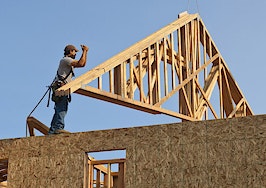- Brokerages may be able to better compete with listing portals by showcasing their local expertise.
- That might mean publishing neighborhood "insights" from agents or offering listing search based on points of interest, among other features offered by Century 21 Redwood Realty's new website.
For years, Alex Perriello, CEO of real estate franchising giant Realogy, has been encouraging real estate brokers working under the company’s various brands, including Century 21, to leverage their agents’ local knowledge on their websites to “counter the superior engineering” of large national websites, according to Edward Berenbaum, president of Arlington, Virginia-based Century 21 Redwood Realty.
After more than two years of work costing more than $1 million, Berenbaum said he believes his brokerage, whose 400 agents cover the Washington D.C. metro area, has realized Perriello’s vision.
Century 21 Redwood Realty recently launched a website that leverages its “boots on the ground” knowledge to craft a one-of-a-kind search experience centered around neighborhoods (nearly 1,500 neighborhood pages), more than 800 “insights” contributed by agents, around 150 “points of interest,” like subway stations and Whole Foods locations, and schools (more than 1,000 school pages).
The site is a bid by the brokerage to generate a wealth of online leads to anticipate the changing real estate landscape without having to advertise on listing portals.
Neighborhood pages

Screenshot showing c21redwood.com’s neighborhood page for the Washington, D.C. neighborhood of Clarendon.
Many of the website’s neighborhood pages use custom boundaries drawn by Redwood Realty, rather than those provided by a data provider like Maponics or Onboard Informatics. Users can look up neighborhood pages with neighborhood boundaries delineated by Redwood by selecting the “Research” option on the home page’s search bar and entering the name of a neighborhood. (Users who search neighborhood names after selecting “buy” or “rent” from the search bar’s drop-down menu will see listings mapped to Maponics neighborhood boundaries, not the custom boundaries drawn by Redwood.)
Redwood’s neighborhood boundaries capture some smaller neighborhoods that haven’t been mapped by third-party providers and sometimes more accurately map neighborhoods that have been indexed by third-party providers, Berenbaum said.
“Our agents know that if you’re on the west side of 16th street, you live in Dupont Circle and if you’re on the east side” you live in Logan Circle, he said, citing one example of an geographic subtlety lost on neighborhood boundary data sets.
Each neighborhood page features nearby listings as both thumbnail images and pins on a map highlighting the neighborhood, with Redwood’s own listings appearing first.
Visitors can read a description of the neighborhood written by Redwood and view 10 original photos taken on behalf of the brokerage, nearby sold listings and neighborhood market statistics.

Neighborhood “insights” on the neighborhood page for Ashburn, Virginia.
Insights
Embodying the website’s focus on milking agents’ local expertise for value, “insights” also appear on neighborhood pages. Insights are comments on neighborhoods contributed by Redwood agents that are supposed to offer prospective buyers the inside scoop on communities, often focusing on nearby amenities, like local restaurants and shops.
Agents are motivated to contribute insights for three reasons, Berenbaum said.
1. They offer an agent exposure on the website.
Their head shot appears next to their insight and links to the agent’s bio page, where visitors can fill out a contact form to reach the agent.
2. Insights also appear on the agent’s bio page, putting their local knowledge on full display to those who might be researching the agent.
3. Agents pay a smaller referral fee to Redwood for online leads generated by insights that convert into transactions than the fee they pay for other types of leads supplied by Redwood.
Agents can offer local color on neighborhoods through insights, but they are barred by Redwood from commenting on a number of community characteristics. That’s so they don’t inadvertently flirt with fair housing laws that can make it risky for agents to discuss subjects like race, familial status, crime and even schools.
“Nobody talks about a neighborhood being perfect for families,” Berenbaum, offering an example of a statement an agent would be prohibited from making in an insight. “They can’t say, ‘It’s safe.’ They can’t say, ‘The schools are great.'”
Unlike neighborhood pages that appear on some other real estate sites, Redwood’s website also doesn’t show demographic statistics. Berenbaum said that’s because its custom neighborhood boundaries often don’t match the boundaries paired with demographic statistics by data providers.
Points of Interest search

C21redwood.com users can click on any station on a subway map to see nearby listings and learn about the surrounding area.
Redwood’s website has also made it possible to search for properties based on their proximity to points of interest, such as specific Whole Foods or subway locations. These pages also can host agent insights.
“Rosslyn has Metro’s 5th longest escalator among all stations in the area. Walk up the escalator for a quick, intense cardio work that will have you trying to catch your breathe by the time you get to the top!” reads an insight from Matthew Leighton on Redwood’s Rosslyn subway stop page.
Further dialing up the website’s local focus are more than 1,000 public school pages. Users land on the pages after searching for schools on the site’s main search tool. The pages feature original photos, local market statistics and all listings located within the school’s attendance boundaries.
Agents who submit insights for school pages, awkwardly, can’t comment on a school itself, only its surroundings. Redwood plans to stitch school ratings from GreatSchools into its school guides in the coming months.
Berenbaum wants to use the new website to bring online lead generation almost fully under its own roof. Redwood used to acquire online leads by advertising on listing portals. It would then feed those leads to its agents in exchange for referral fees when those leads converted into closings.
But Redwood stopped advertising with portals in late December. The plan now is to attract leads organically by offering a one-of-a-kind search experience and advertising the website through digital marketing, such as through Facebook ads that invite users to learn about neighborhoods and then link to the site’s neighborhood pages.









